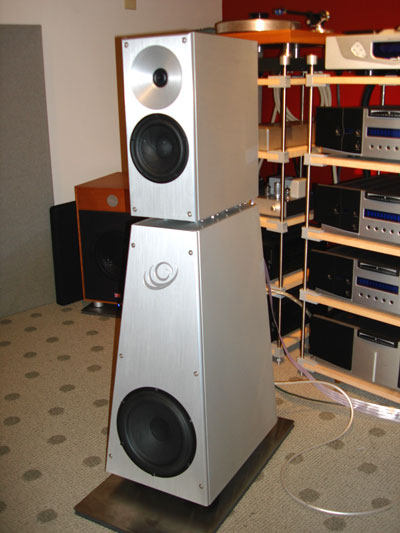
The consumer model, dubbed Anat Reference Professional, retailing for $92,000 per pair, had won the top industry accolades from Hong Kong and Japan, and found owners in the top reviewing circles in the region. On the other hand, the professional model, dubbed, Anat II, is made exclusively for the recording industry, and accordingly to Yoav Geva, the president of YG Acoustics, has been subsequently adopted by the Rod Steward Studio as well.
The June 1st, 2007 demonstration of YG Acoustics at Audio Vision San Francisco was on a smaller model, the Kipod Studio. Retailed at $38,000 per pair, the 104lb Kipod Studio (41-inch tall) in purely passive configuration was supposed to have retained the refinement of the passively configured, 280lb, Anat Reference Professional (69-inch tall), but at a reduced output capacity.
The Kipod system is consisted of the Kipod Studio Main Module ($17,000 per pair) and the Kipod Studio Sub ($21,000 per pair). Audiophiles have the option of purchasing the subwoofers in either passive configuration, or in the active mode with a built-in amplifiers at the same price.
Previously manufactured in its Israel facility, the YG Acoustics loudspeaker systems are now, according to the company, manufactured entirely in the U.S. using industrial machineries and tools as listed on its website, such as Haas (American) for the CNC milling and lathing of the loudspeakers’ cabinet, Iscar Cutting Tools (Israel) for producing the end-mills and carbide bits, Trumpf (Germany) machines for CNC laser cutting, water cutting and bending, Kuhlemeyer (Germany) CNC polishing robots, ERSA (Germany) lead-free soldering systems, Handle Unwelttechnik (Germany) chemical-environment stabilization systems, Steidle (Germany) automatic lubricooling devices, and GLW (Germany) and WDT (Switzerland) automatic cable processing systems.
In retrospect, audiophiles would perhaps be most interested in knowing that YG Acoustics utilizes Scan-Speak/Vifa drive units, Kimber Select cables, Mundorf crossover components and WBT connectors in their loudspeakers.
The AV SF demonstration took place in a room that, from memory, measured around 15-feet wide, 9-feet tall and 18-feet deep. I can’t be certain of the dimensions as my repeated email inquiries to the retailer were never answered. Yoav demonstrated the loudspeakers with music by the American rock band, Extreme, as well as a version from a number off Bach’s The Well Tempered Klavier by The Swingle Singers, and Carl Off’s Carmina Burana from the Usher Audio demo CD.
For $38,000 the pair, the YG Acoustics Kipod was priced among the higher echelon of loudspeaker offerings in the industry, and although Yoav emphasized repeatedly to the audience during the demonstration that the Kipod would not carry itself the same way as the larger Anat, the Kipod sounded mightily loud and balanced to my ears, as driven by Simaudio’s $10,500, Moon W-8 stereo power amplifier.
The pure-aluminum construct of the Kipod yielded a surprisingly musical sound that shattered my lifelong impression of the sounds of metal-cabinet speakers. On the other hand, the room wasn’t an optimal environment for the Kipod, even possibly too small, due to the noticeable resonance in the lower and upper midrange. In addition, the Kipod with its 82dB/8Ω nominal impedance could possibly sound more refined with more powerful amplifications, such as Dagogoan Ed Momkus’ Pass Labs X600.5 solid-state monoblocks, the review of which is now published in Dagogo’s current Issue (July, 2007).
- (Page 1 of 1)
